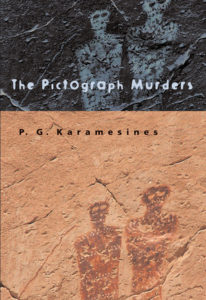 Title: The Pictograph Murders
Title: The Pictograph Murders
Author: P. G. Karamesines
Publisher: Signature Books
Year Published: 2004
Genre: Novel
2004 AML Novel Award winner
(Reviewed by Michael Austin)
I stumbled on The Pictograph Murders in a used bookstore about a month ago, and, though I knew very little about it, I did recognize the author, so I I took a chance. I’m glad I did. It was a curious, and, in some ways, a difficult book, but it was one of those difficult books that is worth the effort that it takes to read it and struggle with its meaning for a while. It is the sort of book that yields both its secrets and its pleasures to a sort of sustained engagement and concentrated attention. But it is also a cool story about some archaeologists, and who doesn’t love those?
It is not, as others have pointed out, strictly a murder mystery. Though it is called The The Pictograph Murders, there is only one obvious murder, and it occurs very late in the book, and there is not really much of a mystery about who done it. There is mystery, of course, but it is a mystery of why and not who. And then there is the title to struggle with. The author is both careful and precise, so it is unlikely that she just miscounted the number of murders in the text–there has to be a reason that it is plural.
This is part of what one might describe as the intellectual mystery–not who killed who for what reason? But, “what is the author trying to do and who are the other murders that she talks about?”
The novel uses a split point of view very effectively. There are two viewpoint characters: 1) Alexandra McKelvey–an English major on an archeology dig in the Four Corners area of the Southern United States; and 2) a character described for most of the novel as “Coyote,” the major trickster from Navajo mythology, who is actually a human being who experiences the world as a mythological character. He both magical and mad in some proportion, though the ratio is kind of a moving target.
As I read the novel, Karamesines is trying to do a lot of different things–all of them well worth doing, and most of which can be broadly termed “intellectual mysteries.” Among these are:
–Meditating on the ways in which myths are true
–Exploring the limitations of what we alternately call “science” and “reason”
–Synchronizing Native American myths with Christian myths and adding a fair bit of Mormon theology into the mix
–Exploring the ethics of conducting archeological research in somebody else’s sacred space
–Exploring what “sacred space” actually means
–Gesturing at connections between myth and language
And in all of this, she gives a good description of a modern archeological dig–at least it matches the three days that I spent last summer on an archeological dig, so, now that I am an “expert,” I can say that Karamesines must be one too.
The only practical criticism that I have of the book is that it introduces too many characters who don’t really play an important role in the story–this confuses the narrative a little bit and makes it hard to keep track of the characters who really are important. I found myself having to flip back a lot and figure out exactly who a character was before concluding that said character really did not play that much of a role in the story.
But this is a small criticism in what I found to be a thoroughly engaging, intelligent, and spiritually nourishing work of art. I still don’t know why the title speaks of plural “murders,” but I am going to think about that for a while, as I suspect that the answer is probably the most important thing I am missing about the book.
